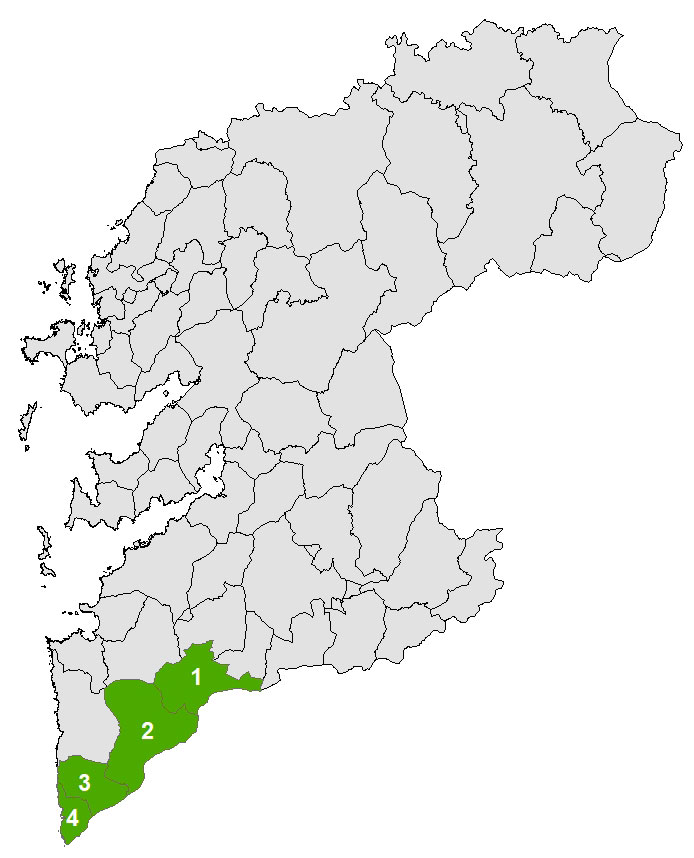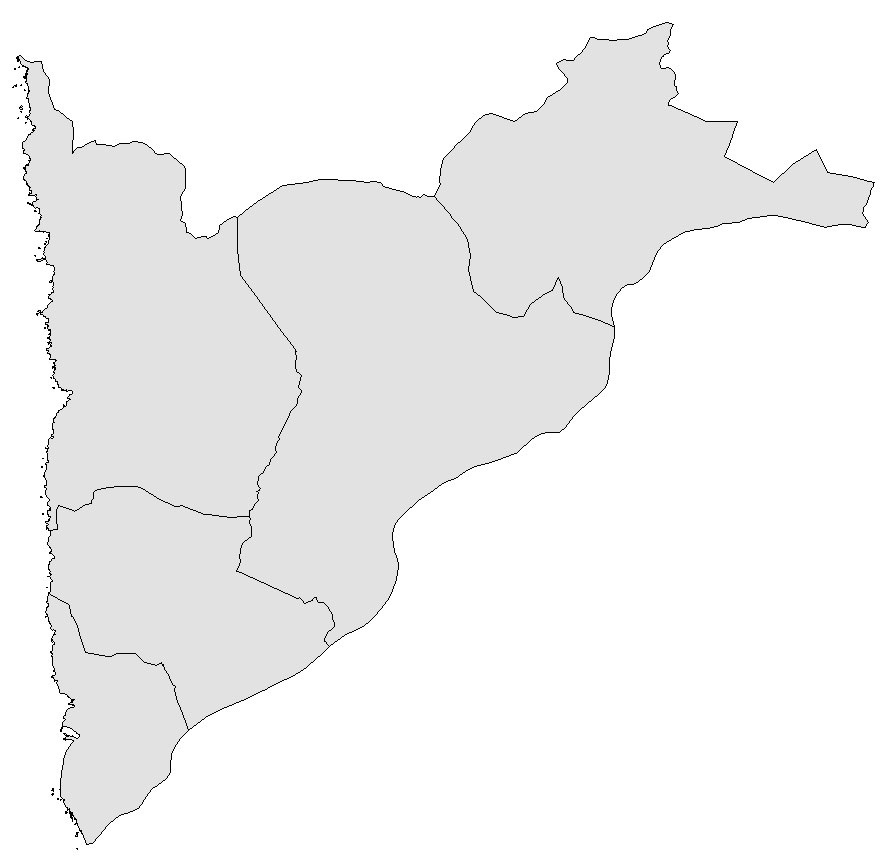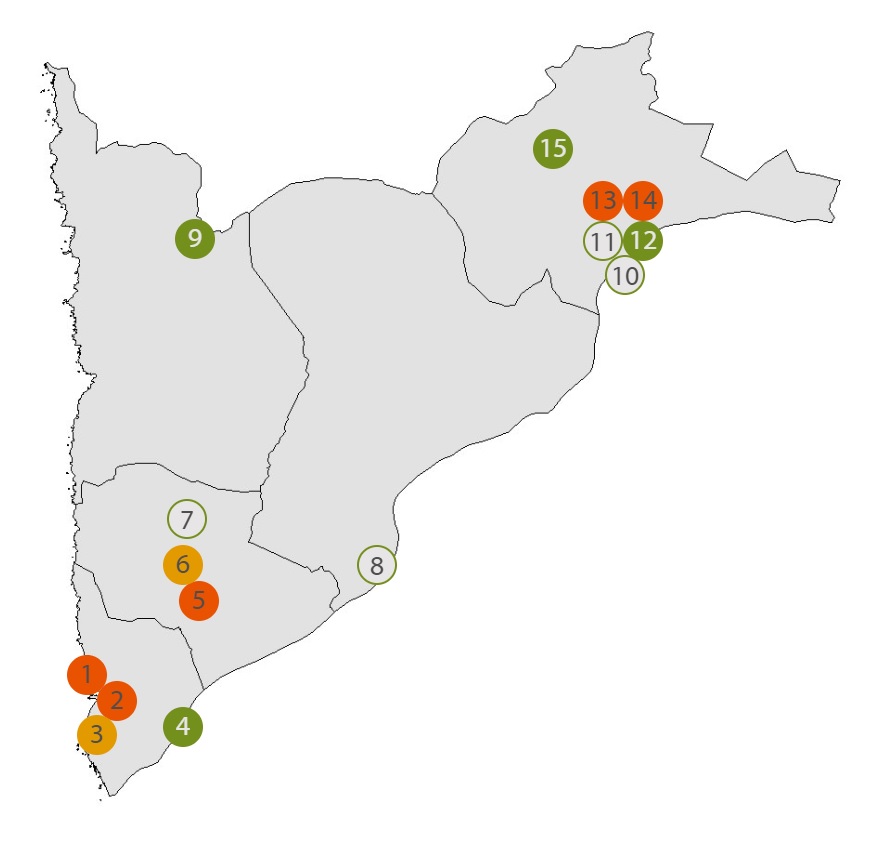03.EXPERIENCE THE REGION OF O BAIXO MIÑO
THE SACRED IN NATURE AND THE CONTROL OF THE LAND
THE SACRED IN NATURE AND THE CONTROL OF THE LAND
Enjoy a land full of contrasts in which the Miño River and the Atlantic Ocean create many different landscapes: such as the high hills of A Grova and O Galiñeiro, or the rivers that flow through the lands down to the calm estuary that merges into the sea. The Miño River serves as a natural border between Portugal and the town of Tui, which was a strategic spot and an episcopal see. Moreover, it gathers a valuable religious heritage.
Visit the towns of O Rosal, A Guarda, Tomiño and Tui and get to know the essence of O Baixo Miño, closely linked to the sea and the Miño River. This has been a strategic spot since prehistory, as evidenced by the pre-Roman fortified settlement Citania de Santa Trega, which dominated the mouth of the Miño River in the Celtic and Roman times, or by the castles located in key spots to control the river.
However, perhaps one of the places with more history in O Baixo Miño is the town of Tui, which became an important urban area and a hub of communications in Roman times. In fact, the Roman Via XIX ending in Braga (Portugal) passed through this town and crossed the Miño River. Later, the well-known international bridge, connecting the two banks of the river, was built, thus serving as a link between the town of Tui and Portugal. Moreover, Tui is an artistic and monumental religious treasure. It is an episcopal see, with an important cathedral and religious art collections showing the power of the church, but also reflecting religious sobriety with austere monasteries, convents or churches located in the narrow streets and alleys of the old part of the town.
The region has been closely linked to both the sea and the countryside, as evidenced by the Museo do Mar (Museum of the Sea) and the Roman salt mines of the fishing town of A Guarda, or by the ethnographic museums and mills, which show the everyday life of the peasants in the fertile valleys.

- 1 - Tui
- 2 - Tomiño
- 3 - O Rosal
- 4 - A Guarda


MUSEUMS
-
It is located in a former defensive circular fortress. It shows A Guarda's sea heritage and its inshore fishing tradition.
-
Pre-Roman hillfort settlement that controlled the territory surrounding the mouth of the Miño River. The citania was occupied from the 4th century BC to the 1st century AD. It is enclosed by a wall and with independent circular or oval houses. The museum exhibits a variety of artefacts such as pottery, glassware, beads, bracelets...
-
Ethnographic centre, located in the former Cámara Agraria (Local Agricultural Office) of the town of O Rosal. It is aimed at promoting the traditional trades, including the cabaqueiros, manufacturers of tiles and bricks, which were very important thanks to the abundance of water and clay ponds in this area.
-
It is situated in the former hospital for the poor and pilgrims dating from 1756. It keeps archaeological pieces and a valuable collection of sacred art which belongs to the Diocese of Tui-Vigo. The museum also exhibits relevant paintings from the 17th-19th centuries, as well as the unique sambenitos, large pieces of fabric painted in the 17th century.
-
It is located in the Cathedral of Tui, in the Chapel of Saint Catherine. It consists of objects that are part of the cathedral’s treasure: liturgical objects and ornaments such as a polychromatic statue of the Virgin (from the late 14th century or early 15th century) and a monstrance created by Juan de Naṕoles Mudarra in 1602. In the cloister, there are tombstones and sepulchres from medieval times.
OTHER POINTS OF INTEREST
-
A group of sixty hydraulic mills from the 17th and 18th centuries, some of them located on the hillside of Campo do Couto and others on a bank of O Picón River. There are different types of mills, but the most common are the horizontal-wheeled watermills, used for grinding grain, especially corn.
-
Dating from the 18th century, it served to control the river and the beach in Vila Nova de Cerveira. Inside, there was a munitions dump, a chapel and the governor’s house, the chaplain's house, warehouses, barracks, stables and wells to supply water to the soldiers.
-
This bridge was designed by the engineer Pelayo Mancebo y Ágreda and inaugurated in 1886. It consists of a long metal structure in the shape of a drawer. This bridge is situated over the Miño River and connects the towns of Tui (Spain) and Valença do Minho (Portugal) by both road and rail.
-
Tui is a unique and outstanding example of a walled medieval town, located on a hill and topped by the cathedral of Santa María, with winding arcade streets, staircases and alleys. Its monuments, namely the cathedral, its old convents and churches, are influenced by the Suebi, Visigoth and medieval cultures.
CULINARY MOMENTS
-
Festival of Tourist Interest in Galicia that is celebrated in July where one can taste grilled or boiled lobster at affordable prices. Moreover, other products such as goose barnacles, squid, king prawns, mussels, razor shells or octopus can be enjoyed. And, for dessert you should try the rosca de xema, an egg yolk ring-shaped cake typical from A Guarda.
-
Festival of Tourist Interest in Galicia that is celebrated every year on the third weekend of July. It is devoted to the wine from O Rosal, under the Designation of Origin Rías Baixas. The wineries display their products and participate in a tasting contest. Moreover, visitors can taste this wine paired with local products.
Some of the wineries where you can taste the wines under the Designation of Origin Rías Baixas of the subzone of O Rosal are:
Terras Gauda (O Rosal)
Road Tui-A Guarda, km 55, 36760 O Rosal
Tel.: +34 986 621 001
[+] INFO
Lagar de Fornelos (O Rosal)
Road of Loureza, 86, 36770 O Rosal
[+] INFO
Adegas Valmiñor (O Rosal)
A Portela, s/n, 36760 O Rosal
[+] INFO
NATURAL SPOTS
-
It is a protected natural area considered one of the most important wetlands in the Iberian Peninsula. It has both freshwater and marine ecosystems and it is an important migratory point for birds, and has a rich wildlife.
-
It is a rocky hill near the coast with low scrubland, pine trees and oak trees in the valleys. It covers the towns of Tomiño, A Guarda, Oia, Baiona and Gondomar, with interesting points such as the Lousado Hill, the Alto da Grova or A Pedra da Gata, which offer beautiful panoramic views.
-
It runs along the banks of the Miño River and offers pleasant views of the river and the international bridge. There, you can also sail the river or do kayaking.
-
It was the first Natural Park in Galicia (1978) and it is located in the southern border of O Galiñeiro Hill. The Aloia Hill offers stunning views of the valley of the Miño River. It has a network of trails, viewpoints and picnic areas, as well as an interpretation centre inside the old forest house.
OTHER POINTS OF INTEREST
- Castro of Alto dos Cubos
Pre-Roman hillfort settlement from the Iron Age located in the Natural Park of the Aloia Hill, which used to control the farming lands and the valley. It consists of three walled complexes that surround circular buildings.
[+] INFO - Convent of As Clarisas – Monjas Encerradas
This convent of the enclosed religious order of the Clarisses was founded in 1517 on the grounds of a former medieval abbey. The church and the monastery, which have been preserved, date from the 17th and 18th centuries and were built in the Mannerism and the Portuguese Baroque styles.
- Jewish Route in Tui
Tui preserves a significant heritage linked to the Jewish community that used to live in the city, such as the sambenitos (tunic wore by penitents during the Spanish Inquisition displayed in the Museo Diocesano de Tui), the Casa de Salomón, the menorah in the cloister of the Cathedral, the synagogue or a Jewish butcher shop. The route is signposted and the Town Council organises free guided tours.
[+] INFO - Spa of Caldelas de Tui
The hot springs of Caldelas de Tui have always been used for bathing by the locals. However, it was in 1882 when Antonio Oliver Rubio (1843-1900) discovered its healing properties and built, next to a large hotel, a spa to treat respiratory, dermatological and musculoskeletal problems.
[+] INFO - Tour of the Casas Indianas (A Guarda)
It is one of the most interesting architectural groups of casas indianas in Galicia. They are the American-style houses – which are characterized by the use of tile and forge – of the old emigrants to America who returned to their hometown. Most of them were built in the second half of the 19th century and the beginning of the 20th century.
[+] INFO
CULINARY MOMENTS
- A Guarda’s fish market
It is located by the port and can be visited on working days in the afternoon when boats arrive with their catches of all types of fish and shellfish. There, it is also possible to buy lamprey.
NATURAL SPOTS
- Fishermen’s path Río Miño-Tamuxe (PR-G112)
A 7-km trail starting in As Eiras Beach and ending in the recreational area by the Tamuxe River. It offers stunning views over the estuary of the Miño River, and passes through riverside woods, pine trees, reed beds, rushes and sandbanks. It is worth visiting the steam sawmill and the mill of As Aceñas.
[+] INFO













